The tech job market in 2025 is a real rollercoaster ride. January started strong, adding 228,000 IT roles. This marks the second straight month of growth — a breath of fresh air after the wild layoffs we saw in 2023-2024.
Companies posted 51,000 new tech job listings in January alone. Despite this positive momentum, the tech unemployment rate sits at 2.9%. This is still well below the national average of 4%, but it’s up from 2% in December 2024
AI adoption is no longer just hype — it’s transforming everything from healthcare to finance to marketing. Remote work remains strong but is evolving, with 33% of employers requiring “onsite” office work. Upskilling is another big topic — learn more, earn more.
One concerning trend is the decline in entry-level tech jobs. Companies want experienced PROs, making it harder for newcomers to break in. For more info, read my “How To Get Into IT Without a Degree in 2025” post
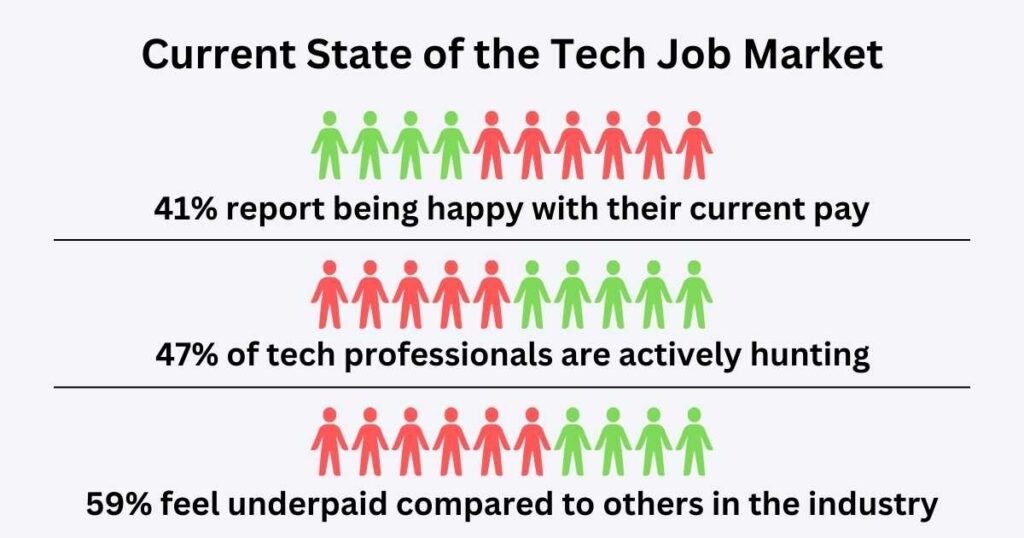
Current State of the Tech Job Market
The 2025 tech job market is “rough” and “frozen.” Some say it’s even tougher than it was back in those days.
The Great Tech Layoff Wave
The first quarter of 2025 has been brutal for tech workers. Nearly 30,000 tech jobs have vanished in just three months. About 100 tech companies worldwide have cut their workforce, with Silicon Valley taking the biggest hit — 20,000 jobs gone!!
This continues the troubling pattern we saw last year. In 2024, 549 tech companies laid off 152,472 employees!! Some think these layoffs stem from AI implementation. Others believe companies are correcting their over-hiring during the pandemic boom.
Major tech companies are opting for lower-cost labor while reducing their workforce in the United States
Don’t panic! Yes, there are layoffs. But tech is still one of the best industries to be in. Companies will always need tech talents —it just might not look exactly the way it did five years ago!!
Unemployment Rates and Job Seeker Challenges
An unprecedented 47% of tech professionals are actively hunting for new roles in 2025, way up from 29% last year. Many feel underpaid and overworked after surviving rounds of layoffs that left teams stretched thin.
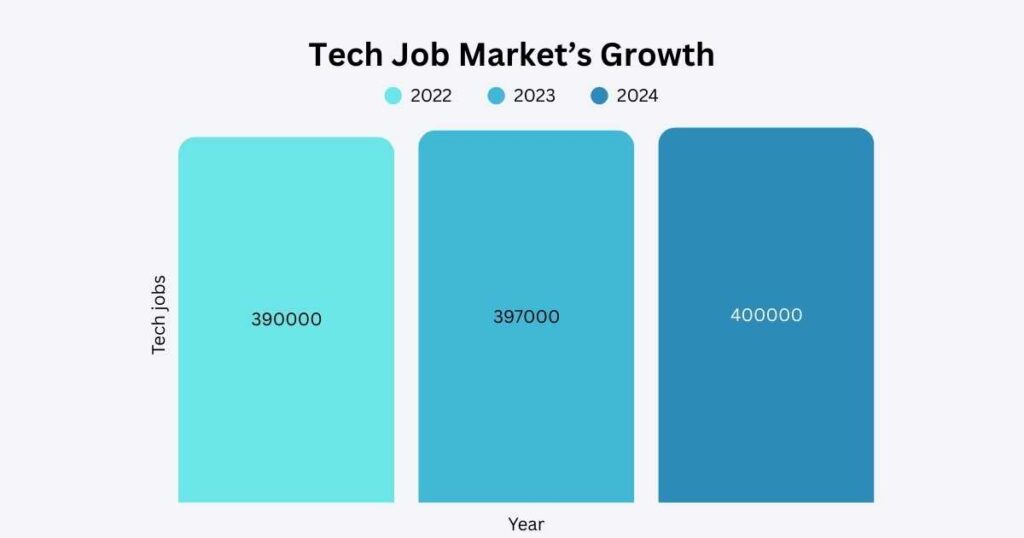
The industry’s growth has basically flatlined — there were:
- 390,000 tech jobs in 2022,
- 397,000 in 2023,
- and just 400,000 in 2024 (that’s barely any growth at all)
The proportion of high-tech professionals among job seekers is climbing…
…It jumped from 6.3% in January 2019 to 11.3% in February 2025 — almost doubling in six years!! Juniors are facing the toughest challenges.
The Skills Paradox: Layoffs Amid Talent Shortages
The weird part — despite all these layoffs, companies still can’t find enough people with the right skills. By 2026, over 90% of global organizations will face IT skills shortages. This could lead to $5.5 trillion in losses due to product delays.
Ready to start learning? Read my “Most Recent Frontend Interview Questions in 2025 With Answers” post.
The most in-demand skills in 2025 are focused on AI. About 26% of tech job postings now require AI expertise — a massive 98% year-over-year increase. Other hot skills include computer-aided design (155% growth) and business software proficiency (133% increase).
The Changing Nature of Tech Employment
The average tech salary has reached $112,521. But job satisfaction is dropping. Only 41% report being happy with their current pay, while 59% feel underpaid compared to others in the industry.
52% of companies worldwide have formalized hybrid work arrangements. 62% of workers accept a 10% pay cut to keep working remotely.
Contract work is also becoming a major employment model in 2025. About 40% of managers plan to use contractors.
Predictions for the Tech Job Market
There hasn’t been much real job growth lately. We are not seeing growth after the “rollercoaster” of recent years. High-tech unemployment has risen by 12% in recent months.
More companies are hiring for AI and cybersecurity roles. Companies are hiring engineers who build and maintain AI systems. Governments are also pushing for stronger security rules — more jobs in this space!!
Yet, market recovery is a big question mark. Some experts say hiring will pick up by mid-2025. Others think we’ll see more layoffs before things get better. Historically, tech has always bounced back. But the 2025 job market is different (probably!?) because of AI and automation.
Some areas — like traditional IT support — shrink. Others — like AI development and cloud computing — are exploding.
At the end of the day, tech jobs aren’t going away, but they are changing FAST!!
Will the 2025-2026 Market Recover?
The tech job market is buzzing with predictions.
The tech job market in 2025 shows signs of recovery, but it’s not the boom many hoped for.
According to CompTIA’s “State of the Tech Workforce” report, tech jobs in the U.S. will grow at twice the rate of the overall workforce over the next decade. The Bureau of Labor Statistics backs this up, projecting 356,700 annual job openings in computer and IT occupations from 2023 to 2033.
The recovery will be uneven across sectors and roles.
Analysts claim big changes in the next 12-18 months. Forecast reports from major firms show mixed signals. Some say the market will bounce back like it did before.
I remember seeing a dip like this back in 2008, and it bounced back stronger.
Sector-Specific Insights: Web, Mobile, Tablet, OTT, Game Consoles, Cars
The tech job market in 2025 is expanding beyond traditional platforms. New opportunities are popping up in exciting sectors that weren’t even on our radar a few years back.
| Role | Platform Focus | Key Skills |
|---|---|---|
| Front-End Web Developer | Web | HTML, CSS, JavaScript, TypeScript |
| Back-End Web Developer | Web & Mobile | Python, Ruby, Java, Node.js, SQL |
| Full-Stack Developer | Web & Mobile | Front-end and back-end tech |
| iOS Developer | Mobile (iOS) | Swift, Objective-C |
| Android Developer | Mobile (Android) | Kotlin, Java |
| Desktop Application Developer | Desktop | C#, Java, C++ |
| DevOps Engineer | Cloud & Web | AWS, Azure, GCP, virtualization, CI/CD, Docker, Kubernetes |
| Machine Learning Engineer | AI/ML | Python, TensorFlow, PyTorch |
| Data Scientist | AI/ML | Python, R, SQL, data visualization |
| Unity Game Developer | Game | C#, Unity, 3D modeling |
| Unreal Engine Game Developer | Game | C++, Unreal Engine |
| UX/UI Designer | Web/Mobile/Desktop | Design, prototyping, usability |
| Software Development Engineer in Test | Web/Mobile/Desktop | Testing frameworks, automation, QA |
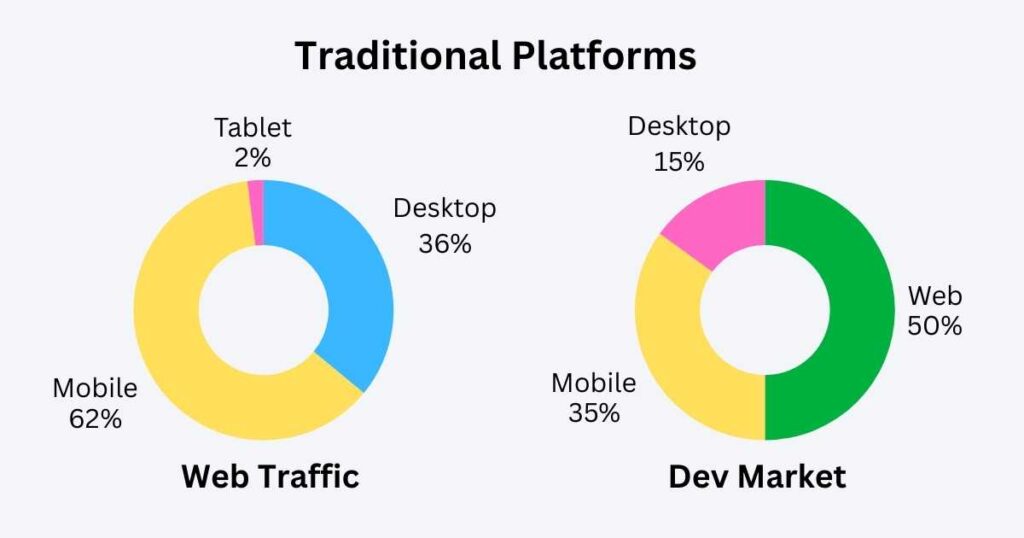
Traditional Platforms: Still Going Strong
Web, mobile, and desktop development continue to dominate. The split between development platforms shows clear trends:
- Tablets trail at just 1.85%
- Mobile dominates with 62.23% of global market share
- Desktop follows at 35.91%
However, web dev shows a market share of around 50% of all developers. Mobile accounts for about 35%. Desktop covers roughly 15%. Web dev is the backbone, but mobile keeps the vibe “fresh”.
- Web Development: 50% market share, high demand, mostly JavaScript, HTML, CSS.
- Mobile Development: 35% market share, growing fast, top languages include Swift and Kotlin.
- Desktop Development: 15% market share, stable salaries, key languages like C# and Java.
In 2025, web development is expected to reach $74.69 billion and hit $104.31 billion by 2030.
The Mordor Intelligence predicts 34,700 new web developer positions annually through 2032. The tech job market in 2025 is booming with opportunities across web, mobile, and desktop development:
- The Bureau of Labor Statistics projects web developer jobs will grow 8% from 2023-2033, faster than average.
- The global web development market reached $65.35 billion in 2023 and is expected to hit $130.9 billion by 2032
Embedded Systems: The New Digital Frontier
Embedded systems are everywhere — in cars, medical devices, and home gadgets. The global market for these systems is set to jump from $86.5 billion in 2020 to $116.2 billion by 2025.
The automotive software market is growing from $30.15 billion in 2024 to $34.92 billion in 2025 — that’s a massive 15.8% growth rate! And it ain’t slowing down either. By 2029, it’s expected to reach $63.4 billion.
C/C++ are the main languages for automotive software development.
We’ll have about 2 billion connected vehicles on roads worldwide by 2025! These smart rides need tons of software for internet connectivity, remote control systems, and security.
Gaming, OTT, and Beyond
The gaming industry is looking super bright for 2025! 77% of game developers expect industry growth this year, with 90% of studios planning to release at least one new title! Game console development increased by 18%. Techs like VR and AR need Unity/Unreal Engine devs.
OTT (Over-The-Top) job market is equally promising — data shows OTT jobs rose by 20% this year! New job roles include interface designers (smooth UX) and real-time data analysts.
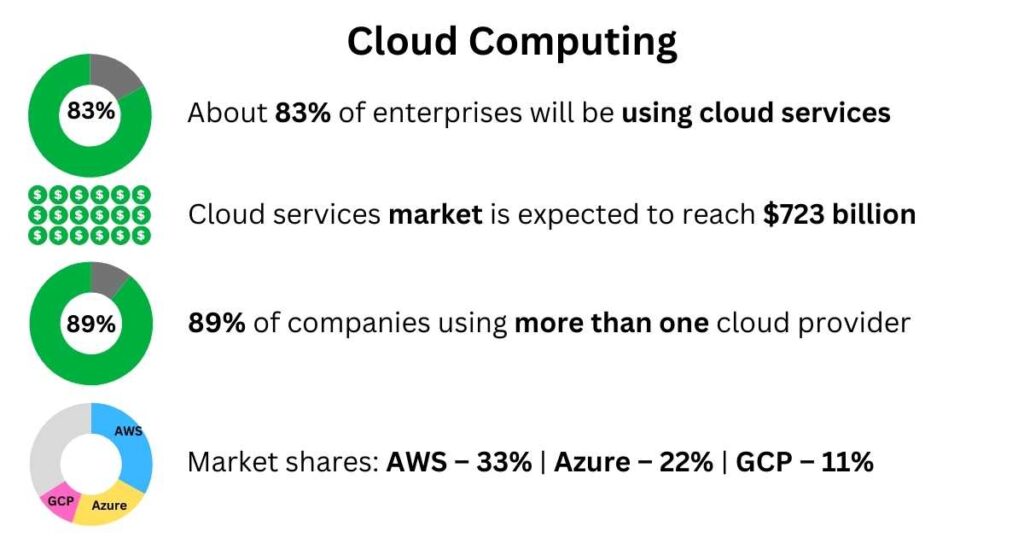
The Rise of Cloud Computing and Deployment
Cloud computing means you store and run apps on someone else’s servers at scale. More companies are moving their stuff to the cloud instead of buying their own servers.
In 2025, about 83% of enterprises will be using cloud services. The cloud services market is expected to reach $723 billion, a 21.5% increase from 2024.
The three big players— AWS, Azure, and Google Cloud — are growing like crazy:
- AWS (Amazon Web Services): 33% market share
- Microsoft Azure: 22% market share
- Google Cloud Platform (GCP): 11% market share
Multi-cloud is now the norm, with 89% of companies using more than one cloud provider. Companies use clouds to run apps (about 57% do this), while others use clouds for disaster recovery or data integration between systems (around 45%).
Top cloud roles include:
- Cloud Architects (design cloud solutions)
- DevOps Engineers (automate deployment)
- Cloud Security Specialists (protect cloud data)
- Data Engineers (build data pipelines in the cloud)
Cloud DevOps need to know Infrastructure as Code tools like Terraform and CloudFormation. Containers tech — Docker and Kubernetes — is super important, too!!
Serverless computing is another trend creating jobs. It lets developers build apps without managing servers.
The competition for cloud jobs is actually less fierce than in other tech areas. With remote work becoming the norm, cloud skills are even more valuable.
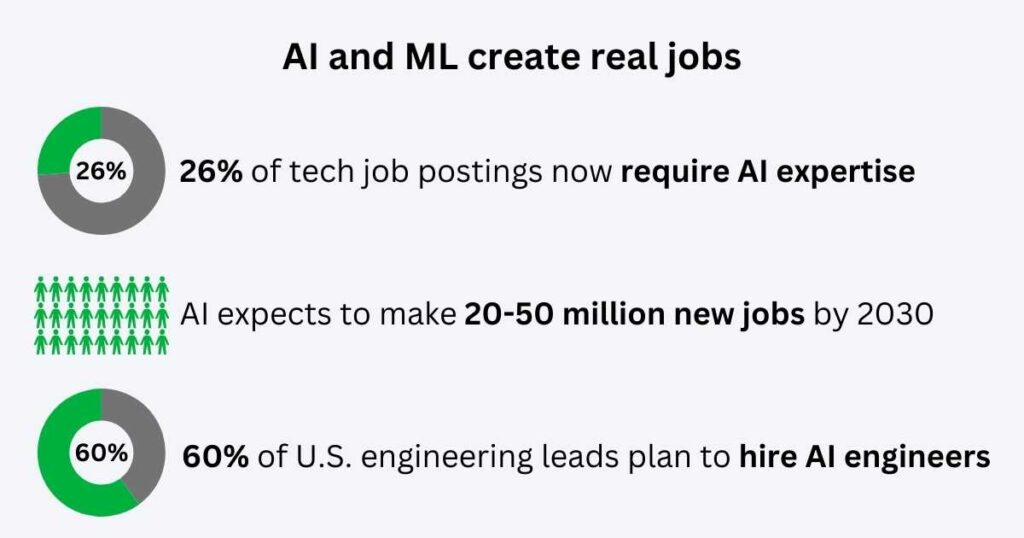
Artificial Intelligence and Machine Learning: New Roles Created by AI and ML
The AI ain’t just hype — it’s creating real jobs. Companies rush to adopt artificial intelligence and machine learning, creating new roles. McKinsey expects AI to make 20-50 million new jobs globally by 2030. 60% of U.S. engineering leads plan to hire AI engineers.
The data shows AI-related job postings peaked at 16,000 in October 2024. Companies like Amazon, Accenture, IBM, Google, Microsoft, and Meta posted thousands of AI job openings throughout 2024.
Healthcare organizations use AI for personalized medicine and diagnostics. Financial companies need AI for algorithmic trading and fraud detection. Retail businesses use it for inventory and customer analysis.
The hottest AI job titles include Machine Learning Engineer, AI/ML Python Engineer, and Generative AI Engineer.
Python is the number one skill to learn. Then come TensorFlow and PyTorch frameworks. Data science fundamentals will help you understand the basics.

Remote Work Trends and Opportunities
Remote work in tech ain’t just a “pandemic thing” anymore — it’s here to stay!! Remote job postings are up 10% from last year and a whopping 31% from six months ago! By 2026, an estimated 32.6 million Americans will work remotely.
In Q4 2024, technology employers posted the highest % of fully remote jobs — 18%! The distribution of work arrangements in tech for Q4 2024 breaks down like this:
- Fully in-office: 60%
- Fully remote: 18%
- Hybrid: 22%
Fortune 500 and public companies have seen a nearly 300% increase in remote jobs. Remote work is experience sensitive. Senior-level positions are more likely to be remote (5.35%) compared to mid-level (4.9%) and entry-level jobs (2.48%)
Policies vary across companies. Amazon requires on-site five days a week. Dell ended most remote positions. Employees near an office must work on-site full-time. Meanwhile, Meta wants you to work from the office at least three days a week (hybrid model).
Salary Trends and Expectations
The average tech pro is now making around $112,521, which is only up 1.2% from last year. Current salary ranges for common tech roles in 2025:
Check out these salary ranges for common tech roles in 2025:
- Software Developers: $90,000-$198,000
- IT Support Technicians: $46,000-$85,000
- IT Project Managers: $73,000-$210,000
- Data Analysts: $81,000-$108,000
- AI/ML Engineers: $140,000-$200,000
- Cybersecurity Analysts: $100,000-$160,000
Here’s something wild — tech workers are willing to accept an average 25% pay cut for hybrid or fully remote jobs. But (plot twist!) employers aren’t lowering wages for remote workers — the high demand isn’t driving pay down.
Conclusion: 2025 Tech Job Market
The tech job market in 2025 is changing fast. Yes, there have been layoffs. But there’s also growth in areas like cloud computing, AI, and new platforms.
Remote work is still huge. Competition’s fierce for juniors, but mid and senior roles are heating up!!
The tech job market ain’t dying — it’s evolving. The future of tech belongs to those who evolve with it — are you ready?





